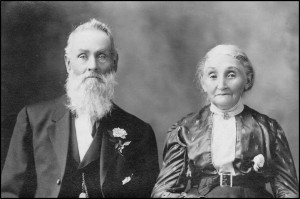In some earlier posts I shared some of the reminiscences of David Ransom Robbins, a grandson of Ransom Robbins, who was the subject of much of the family stories. David’s parents were Jacob Green and Jane (Force) Robbins and they are the subject of this post.
Born in Indiana in 1827, Jacob Green Robbins was the fourth child of Ransom and Rebecca (Green) Robbins. He was raised in Jennings County and married Jane Force, a native New Yorker, there in 1851. To this union were born twelve children.

Grand Review of Union Army (1865)
Jacob enlisted in the 82nd Regiment of Indiana Infantry Volunteers on 9 August 1862in Indiana and served through the duration of the Civil War. The 82nd was involved in the battles of Perryville, Stone’s River, Chickamauga, Atlanta, and was with Sherman when he marched across Georgia and up through the Carolinas to Confederate General Johnston’s surrender. This regiment, with Jacob, participated in the Grand Review of the Armies in Washington, D.C., where Jacob was discharged, honorably, on 9 June 1865. Like many soldiers, Jacob suffered from illness, including diarrhea, piles, and cataracts in the eyes, brought on by exposure to the elements and unclean water and food. His later application for a pension would describe these conditions.
Upon return from the war, Jacob, along with other members of the Robbins family, emigrated from Indiana to Minnesota. A friend of his, whom he had grown up with and served in the same infantry company with, owned land in Minnesota but decided to remain in Indiana and offered the Minnesota place to Jacob. Once the Robbins’ Indiana farm was sold, Jacob and Jane purchased the Minnesota land, and moved there to Scott County.
Jacob and Jane’s son David Ransom Robbins wrote about the family’s arrival in Minnesota:
Uncle Jim Robbins lived about four miles northwest of Waterville…we finally got to Uncle Jim’s. They knew that we was on our way, but did not know when we would arrive. Grandfather [Ransom Robbins] and Aunt Julia’s house was only a short distance from Uncle Jim’s, and they had gone to bed. Uncle Jim called them and they came over. My cousin Ransom was not married yet, and was at home. He was a volunteer soldier in the Fourth Minnesota Regiment and served till the war ended. You can imagine that it was quite late when we got to bed that night.
Initially the Robbins’s lived near Fish Lake. David Ransom Robbins described building their house there.
After father got the house logs made, he took one of the mares and snaked them out of the woods to where he wanted to build the house, and sometime in the last or first part of April of 1866 he had a house raising, and the neighbors came and put up the body of the house, and about that time Uncle Nelson Force (Mother’s brother) came. Then he, father, and Grandfather Robbins made rafters out of saplings by hewing them on one side, then put them up and nailed sheeting on them, which was one inch lumber. And then they put the roof on which was three foot clapboards they had riven out of oak timber. They also made all the joists out of small trees. When they got the floors laid and doors and windows in, and as the weather was quite warm by that time, we moved into our new house before the cracks between the logs were chinked and plastered.

Jacob Green & Jane (Force) Robbins
After living at Fish Lake for about six years, Jacob bought a farm a little to the southwest in Lexington Township of Le Sueur County, and that’s where he and Jane remained until 1911. In that year, at the ages of 83 and 74, Jacob and Jane moved to Oregon! Both family and newspaper articles state that it was in search of a “milder” climate that caused the couple to make the move. Certainly Cottage Grove, Oregon, is much, much milder than Cordova, Minnesota.

Cottage Grove Sentinel (24 October 1912)
The very next year, the Cottage Grove Sentinel spotlighted the elderly Robbins couple, one-year residents of their community, with a headline that stated “Mr. and Mrs. J. G. Robbins Sweethearts Still and Hale and Hearty at Advanced Ages of 85 and 76.” A couple of their many children lived nearby and helped take care of the couple in their last years. When they passed away, they did so within weeks of one another. Jacob Green Robbins died in March of 1918, while Jane passed away two months later, in May of 1918. Both Jacob and his wife Jane are buried in the Brumbaugh Cemetery outside Cottage Grove.
(Jacob Robbins-James Robbins-Ransom Robbins-Jacob Green Robbins)



